英美文学史及选读期末考试常用名词解释
英美文学名词解释整理版
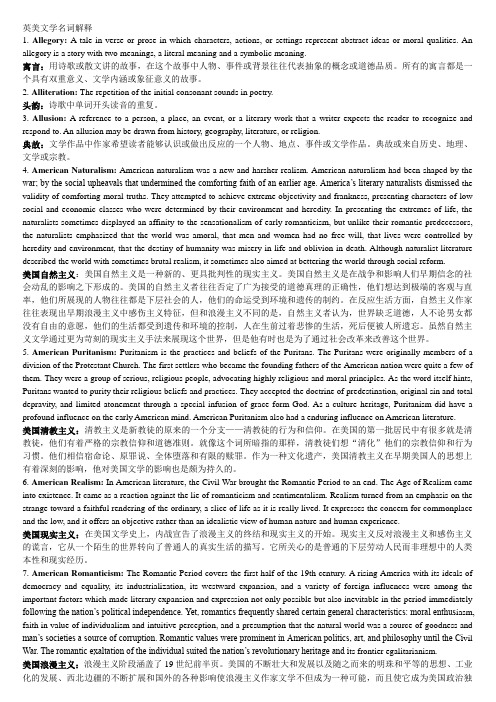
英美文学名词解释1. Allegory: A tale in verse or prose in which characters, actions, or settings represent abstract ideas or moral qualities. An allegory is a story with two meanings, a literal meaning and a symbolic meaning.寓言:用诗歌或散文讲的故事,在这个故事中人物、事件或背景往往代表抽象的概念或道德品质。
所有的寓言都是一个具有双重意义、文学内涵或象征意义的故事。
2.Alliteration: The repetition of the initial consonant sounds in poetry.头韵:诗歌中单词开头读音的重复。
3.Allusion:A reference to a person, a place, an event, or a literary work that a writer expects the reader to recognize and respond to. An allusion may be drawn from history, geography, literature, or religion.典故:文学作品中作家希望读者能够认识或做出反应的一个人物、地点、事件或文学作品。
典故或来自历史、地理、文学或宗教。
4. American Naturalism: American naturalism was a new and harsher realism. American naturalism had been shaped by the war; by the social upheavals that undermined the comforting faith of an earlier age. America’s literary naturalists dismissed the validity of comforting moral truths. They attempted to achieve extreme objectivity and frankness, presenting characters of low social and economic classes who were determined by their environment and heredity. In presenting the extremes of life, the naturalists sometimes displayed an affinity to the sensationalism of early romanticism, but unlike their romantic predecessors, the naturalists emphasized that the world was amoral, that men and women had no free will, that lives were controlled by heredity and environment, that the destiny of humanity was misery in life and oblivion in death. Although naturalist literature described the world with sometimes brutal realism, it sometimes also aimed at bettering the world through social reform.美国自然主义:美国自然主义是一种新的、更具批判性的现实主义。
英美文学名词解释整理版
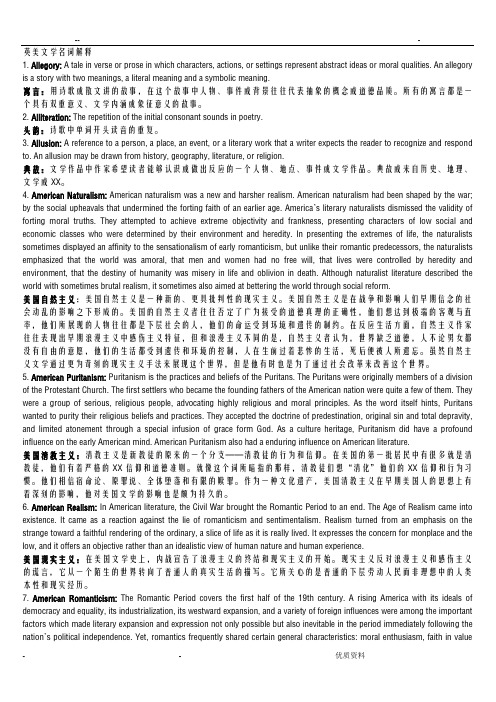
英美文学名词解释1. Allegory: A tale in verse or prose in which characters, actions, or settings represent abstract ideas or moral qualities. An allegory is a story with two meanings, a literal meaning and a symbolic meaning.寓言:用诗歌或散文讲的故事,在这个故事中人物、事件或背景往往代表抽象的概念或道德品质。
所有的寓言都是一个具有双重意义、文学内涵或象征意义的故事。
2.Alliteration: The repetition of the initial consonant sounds in poetry.头韵:诗歌中单词开头读音的重复。
3. Allusion: A reference to a person, a place, an event, or a literary work that a writer expects the reader to recognize and respond to. An allusion may be drawn from history, geography, literature, or religion.典故:文学作品中作家希望读者能够认识或做出反应的一个人物、地点、事件或文学作品。
典故或来自历史、地理、文学或XX。
4. American Naturalism: American naturalism was a new and harsher realism. American naturalism had been shaped by the war; by the social upheavals that undermined the forting faith of an earlier age. America’s literary naturalists dismissed the validity of forting moral truths. They attempted to achieve extreme objectivity and frankness, presenting characters of low social and economic classes who were determined by their environment and heredity. In presenting the extremes of life, the naturalists sometimes displayed an affinity to the sensationalism of early romanticism, but unlike their romantic predecessors, the naturalists emphasized that the world was amoral, that men and women had no free will, that lives were controlled by heredity and environment, that the destiny of humanity was misery in life and oblivion in death. Although naturalist literature described the world with sometimes brutal realism, it sometimes also aimed at bettering the world through social reform.美国自然主义:美国自然主义是一种新的、更具批判性的现实主义。
(完整版)英美文学名词解释最全版
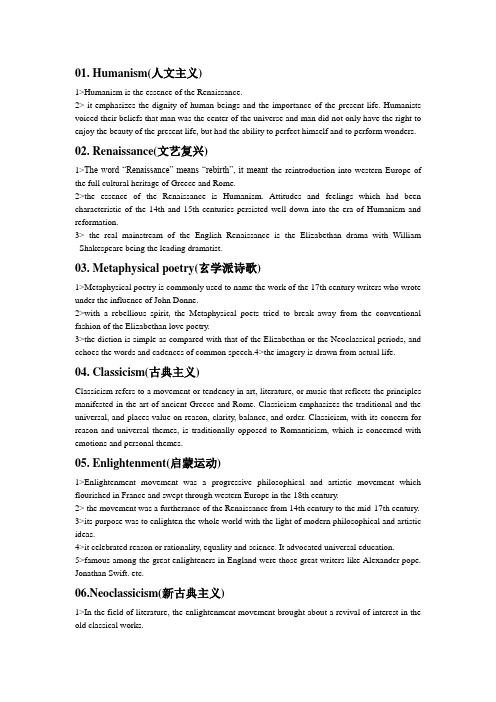
01. Humanism(人文主义)1>Humanism is the essence of the Renaissance.2> it emphasizes the dignity of human beings and the importance of the present life. Humanists voiced their beliefs that man was the center of the universe and man did not only have the right to enjoy the beauty of the present life, but had the ability to perfect himself and to perform wonders.02. Renaissance(文艺复兴)1>The word “Renaissance”means “rebirth”, it meant the reintroduction into western Europe of the full cultural heritage of Greece and Rome.2>the essence of the Renaissance is Humanism. Attitudes and feelings which had been characteristic of the 14th and 15th centuries persisted well down into the era of Humanism and reformation.3> the real mainstream of the English Renaissance is the Elizabethan drama with William Shakespeare being the leading dramatist.03. Metaphysical poetry(玄学派诗歌)1>Metaphysical poetry is commonly used to name the work of the 17th century writers who wrote under the influence of John Donne.2>with a rebellious spirit, the Metaphysical poets tried to break away from the conventional fashion of the Elizabethan love poetry.3>the diction is simple as compared with that of the Elizabethan or the Neoclassical periods, and echoes the words and cadences of common speech.4>the imagery is drawn from actual life.04. Classicism(古典主义)Classicism refers to a movement or tendency in art, literature, or music that reflects the principles manifested in the art of ancient Greece and Rome. Classicism emphasizes the traditional and the universal, and places value on reason, clarity, balance, and order. Classicism, with its concern for reason and universal themes, is traditionally opposed to Romanticism, which is concerned with emotions and personal themes.05. Enlightenment(启蒙运动)1>Enlightenment movement was a progressive philosophical and artistic movement which flourished in France and swept through western Europe in the 18th century.2> the movement was a furtherance of the Renaissance from 14th century to the mid-17th century.3>its purpose was to enlighten the whole world with the light of modern philosophical and artistic ideas.4>it celebrated reason or rationality, equality and science. It advocated universal education.5>famous among the great enlighteners in England were those great writers like Alexander pope. Jonathan Swift. etc.06.Neoclassicism(新古典主义)1>In the field of literature, the enlightenment movement brought about a revival of interest in the old classical works.2>this tendency is known as neoclassicism. The Neoclassicists held that forms of literature were to be modeled after the classical works of the ancient Greek and Roman writers such as Homer and Virgil and those of the contemporary French ones.3> they believed that the artistic ideals should be order, logic, restrained emotion and accuracy, and that literature should be judged in terms of its service to humanity.07. The Graveyard School(墓地派诗歌)1>The Graveyard School refers to a school of poets of the 18th century whose poems are mostly devoted to a sentimental lamentation or meditation on life. Past and present ,with death and graveyard as themes.2>Thomas Gray is considered to be the leading figure of this school and his Elegy written in a country churchyard is its most representative work.08. Romanticism(浪漫主义)1>In the mid-18th century, a new literary movement called romanticism came to Europe and then to England.2>It was characterized by a strong protest against the bondage of neoclassicism, which emphasized reason, order and elegant wit. Instead, romanticism gave primary concern to passion, emotion, and natural beauty.3>In the history of literature. Romanticism is generally regarded as the thought that designates a literary and philosophical theory which tends to see the individual as the very center of all life and experience. 4> The English romantic period is an age of poetry which prevailed in England from 1798 to 1837. The major romantic poets include Wordsworth, Byron and Shelley.09. Byronic Hero(拜伦式英雄)1>Byronic hero refers to a proud, mysterious rebel figure of noble origin.2> with immense superiority in his passions and powers, this Byronic Hero would carry on his shoulders the burden of righting all the wrongs in a corrupt society. And would rise single-handedly against any kind of tyrannical rules either in government, in religion, or in moral principles with unconquerable wills and inexhaustible energies.3> Byron’s chief contribution to English literature is his creation of the “Byronic Hero”10. Critical Realism(批判现实主义)1>Critical Realism is a term applied to the realistic fiction in the late 19th and early 20th centuries.2> It means the tendency of writers and intellectuals in the period between 1875 and 1920 to apply the methods of realistic fiction to the criticism of society and the examination of social issues.3> Realist writers were all concerned about the fate of the common people and described what was faithful to reality.4> Charles Dickens is the most important critical realist.11. Aestheticism(美学主义)1>The basic theory of the Aesthetic movement--- “art for art’s sake” was set forth by a French poet, Theophile Gautier, the first Englishman who wrote about the theory of aestheticism was Walter Pater.2> aestheticism places art above life, and holds that life should imitate art, not art imitate life.3> According to the aesthetes, all artistic creation is absolutely subjective as opposed to objective. Art should be free from any influence of egoism. Only when art is for art’s sake, can it be immortal. They believed that art should be unconcerned with controversial issues, such as politics and morality, and that it should be restricted to contributing beauty in a highly polished style.4> This is one of the reactions against the materialism and commercialism of the Victorian industrial era, as well as a reaction against the Victorian convention of art for morality’s sake, or art for money’s sake.美学运动的基本原则”为艺术而艺术”最初由法国诗人西奥费尔.高缔尔提出,英国运用该美学理论的第一人是沃尔特.佩特.美学主义崇尚艺术高于生活,认为生活应模仿艺术,而不是艺术模仿生活.在美学主义看来,所有的艺术创作都是绝对主观而非客观的产物.艺术不应受任何功利的影响,只有当艺术为艺术而创作时,艺术才能成为不朽之作.他们还认为艺术不应只关注一些热点话题如政治和道德问题,艺术应着力于以华丽的风格张扬美.这是对维多利亚工业发展时期物质崇拜的一种回应,也是向艺术为道德或为金钱而服务的维多利亚传统的挑战.12.The Victorian period(维多利亚时期)1>In this period, the novel became the most widely read and the most vital and challenging expression of progressive thought. While sticking to the principle of faithful representation of the 18th century realist novel, novelists in this period carried their duty forward to criticism of the society and the defense of the mass.2> although writing from different points of view and with different techniques, they shared one thing in common, that is, they were all concerned about the fate of the common people. They were angry with the inhuman social institutions, the decaying social morality as represented by the money-worship and Utilitarianism, and the widespread misery, poverty and injustice.3>their truthful picture of people’s life and bitter and strong criticism of the society had done much in awakening the public consciousness to the social problems and in the actual improvement of the society.4> Charles Dickens is the leading figure of the Victorian period.13. Modernism(现代主义)1>Modernism is comprehensive but vague term for a movement , which begin in the late 19th century and which has had a wide influence internationally during much of the 20th century.2> modernism takes the irrational philosophy and the theory of psycho-analysis as its theoretical case.3> the term pertains to all the creative arts. Especially poetry, fiction, drama, painting, music and architecture.4> in England from early in the 20th century and during the 1920s and 1930s, in America from shortly before the first world war and on during the inter-war period, modernist tendencies were at their most active and fruitful.5>as far as literature is concerned, Modernism reveals a breaking away from established rules, traditions and conventions. fresh ways of looki ng at man’s position and function in the universe and many experiments in form and style. It is particularly concerned with language and how to use it and with writing itself.14. Stream of consciousness(意识流)(or interior monologue)In literary criticism, Stream of consciousness denotes a literary technique which seeks to describe an individual’s point of view by giving the written equivalent of the character’s thought processes. Stream of consciousness writing is strongly associated with the modernist movement. Its introduction in the literary context, transferred from psychology, is attributed to May Sinclair. Stream of consciousness writing is usually regarded as a special form of interior monologue and is characterized by associative leaps in syntax and punctuation that can make the prose difficult to follow, tracing as they do a character’s fragmentary thoughts and sensory feelings. Famous writers to employ this technique in the English language include James Joyce and William Faulkner.学术界认为意识流是一种通过直接描述人物思维过程来寻求个人视角的文学写作技巧。
英美文学史:术语定义总结期末考复习
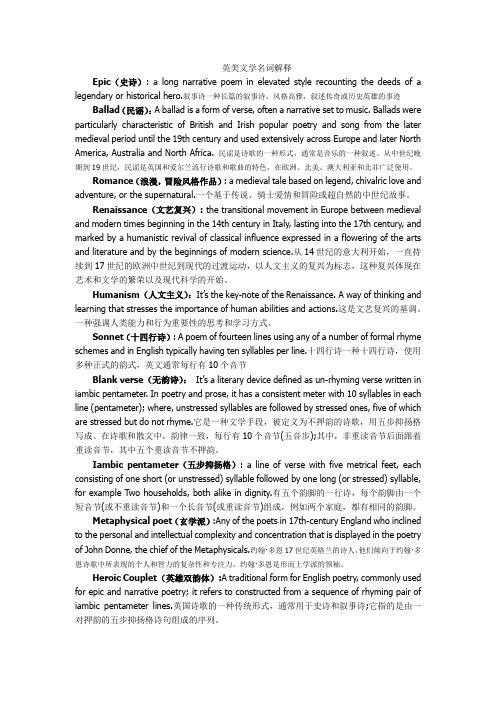
英美文学名词解释Epic(史诗): a long narrative poem in elevated style recounting the deeds of a legendary or historical hero.叙事诗一种长篇的叙事诗,风格高雅,叙述传奇或历史英雄的事迹Ballad(民谣):A ballad is a form of verse, often a narrative set to music. Ballads were particularly characteristic of British and Irish popular poetry and song from the later medieval period until the 19th century and used extensively across Europe and later North America, Australia and North Africa. 民谣是诗歌的一种形式,通常是音乐的一种叙述。
从中世纪晚期到19世纪,民谣是英国和爱尔兰流行诗歌和歌曲的特色,在欧洲、北美、澳大利亚和北非广泛使用。
Romance(浪漫,冒险风格作品): a medieval tale based on legend, chivalric love and adventure, or the supernatural.一个基于传说、骑士爱情和冒险或超自然的中世纪故事。
Renaissance(文艺复兴): the transitional movement in Europe between medieval and modern times beginning in the 14th century in Italy, lasting into the 17th century, and marked by a humanistic revival of classical influence expressed in a flowering of the arts and literature and by the beginnings of modern science.从14世纪的意大利开始,一直持续到17世纪的欧洲中世纪到现代的过渡运动,以人文主义的复兴为标志,这种复兴体现在艺术和文学的繁荣以及现代科学的开始。
英美文学名词解释
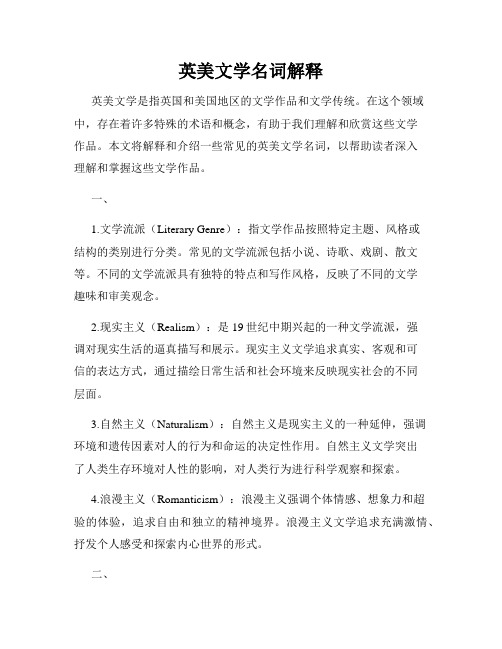
英美文学名词解释英美文学是指英国和美国地区的文学作品和文学传统。
在这个领域中,存在着许多特殊的术语和概念,有助于我们理解和欣赏这些文学作品。
本文将解释和介绍一些常见的英美文学名词,以帮助读者深入理解和掌握这些文学作品。
一、1.文学流派(Literary Genre):指文学作品按照特定主题、风格或结构的类别进行分类。
常见的文学流派包括小说、诗歌、戏剧、散文等。
不同的文学流派具有独特的特点和写作风格,反映了不同的文学趣味和审美观念。
2.现实主义(Realism):是19世纪中期兴起的一种文学流派,强调对现实生活的逼真描写和展示。
现实主义文学追求真实、客观和可信的表达方式,通过描绘日常生活和社会环境来反映现实社会的不同层面。
3.自然主义(Naturalism):自然主义是现实主义的一种延伸,强调环境和遗传因素对人的行为和命运的决定性作用。
自然主义文学突出了人类生存环境对人性的影响,对人类行为进行科学观察和探索。
4.浪漫主义(Romanticism):浪漫主义强调个体情感、想象力和超验的体验,追求自由和独立的精神境界。
浪漫主义文学追求充满激情、抒发个人感受和探索内心世界的形式。
二、1.象征主义(Symbolism):象征主义是19世纪末20世纪初出现的一种文学和艺术运动,强调使用象征性的意象和隐喻来表达深层的情感和思想。
象征主义文学倾向于表达个体的情感体验和心灵探索。
2.现代主义(Modernism):现代主义是20世纪初兴起的一种文学和艺术运动,强调对传统形式和观念的挑战和颠覆。
现代主义文学追求形式上的创新和实验,探索自我意识、哲学思考和社会变革。
3.后现代主义(Postmodernism):后现代主义是现代主义的继承和超越,强调文化多样性、相对主义和戏仿。
后现代主义文学打破传统的叙事和结构规则,以戏仿和颠覆的方式探索权力、真实性和历史观念。
4.现实主义小说(Realistic Novel):现实主义小说以真实的描写和社会批判为特征,通过塑造现实人物的经历和命运来反映社会问题。
英美文学名词解释
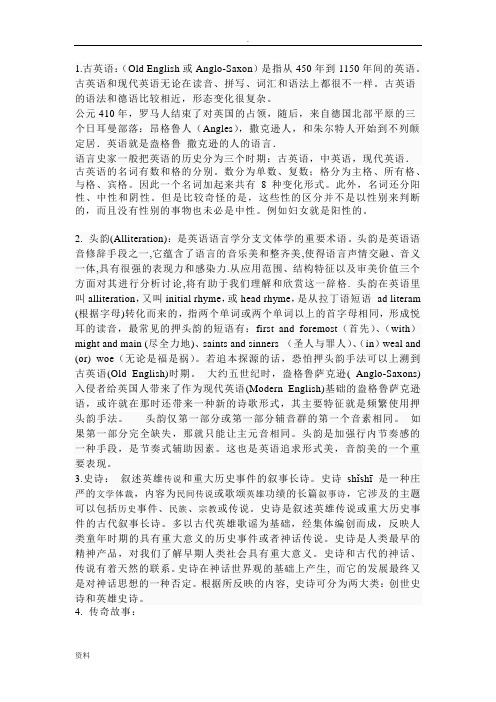
1.古英语:(Old English或Anglo-Saxon)是指从450年到1150年间的英语。
古英语和现代英语无论在读音、拼写、词汇和语法上都很不一样。
古英语的语法和德语比较相近,形态变化很复杂。
公元410年,罗马人结束了对英国的占领,随后,来自德国北部平原的三个日耳曼部落:昂格鲁人(Angles),撒克逊人,和朱尔特人开始到不列颠定居.英语就是盎格鲁_撒克逊的人的语言.语言史家一般把英语的历史分为三个时期:古英语,中英语,现代英语.古英语的名词有数和格的分别。
数分为单数、复数;格分为主格、所有格、与格、宾格。
因此一个名词加起来共有8种变化形式。
此外,名词还分阳性、中性和阴性。
但是比较奇怪的是,这些性的区分并不是以性别来判断的,而且没有性别的事物也未必是中性。
例如妇女就是阳性的。
2. 头韵(Alliteration):是英语语言学分支文体学的重要术语。
头韵是英语语音修辞手段之一,它蕴含了语言的音乐美和整齐美,使得语言声情交融、音义一体,具有很强的表现力和感染力.从应用范围、结构特征以及审美价值三个方面对其进行分析讨论,将有助于我们理解和欣赏这一辞格. 头韵在英语里叫alliteration,又叫initial rhyme,或head rhyme,是从拉丁语短语ad literam (根据字母)转化而来的,指两个单词或两个单词以上的首字母相同,形成悦耳的读音,最常见的押头韵的短语有:first and foremost(首先)、(with)might and main (尽全力地)、saints and sinners (圣人与罪人)、(in)weal and (or) woe(无论是福是祸)。
若追本探源的话,恐怕押头韵手法可以上溯到古英语(Old English)时期。
大约五世纪时,盎格鲁萨克逊( Anglo-Saxons)入侵者给英国人带来了作为现代英语(Modern English)基础的盎格鲁萨克逊语,或许就在那时还带来一种新的诗歌形式,其主要特征就是频繁使用押头韵手法。
英美文学期末复习名词解释
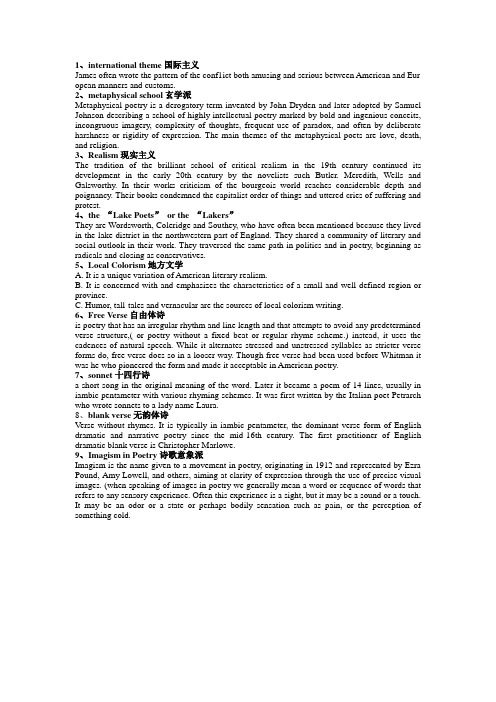
1、international theme国际主义James often wrote the pattern of the conf1ict both amusing and serious between American and Eur opean manners and customs.2、metaphysical school玄学派Metaphysical poetry is a derogatory term invented by John Dryden and later adopted by Samuel Johnson describing a school of highly intellectual poetry marked by bold and ingenious conceits, incongruous imagery, complexity of thoughts, frequent use of paradox, and often by deliberate harshness or rigidity of expression. The main themes of the metaphysical poets are love, death, and religion.3、Realism现实主义The tradition of the brilliant school of critical realism in the 19th century continued its development in the early 20th century by the novelists such Butler. Meredith, Wells and Galsworthy. In their works criticism of the bourgeois world reaches considerable depth and poignancy. Their books condemned the capitalist order of things and uttered cries of suffering and protest.4、the “Lake Poets”or the “Lakers”They are Wordsworth, Coleridge and Southey, who have often been mentioned because they lived in the lake district in the northwestern part of England. They shared a community of literary and social outlook in their work. They traversed the same path in politics and in poetry, beginning as radicals and closing as conservatives.5、Local Colorism地方文学A. It is a unique variation of American literary realism.B. It is concerned with and emphasizes the characteristics of a small and well-defined region or province.C. Humor, tall-tales and vernacular are the sources of local colorism writing.6、Free Verse自由体诗is poetry that has an irregular rhythm and line length and that attempts to avoid any predetermined verse structure,( or poetry without a fixed beat or regular rhyme scheme.) instead, it uses the cadences of natural speech. While it alternates stressed and unstressed syllables as stricter verse forms do, free verse does so in a looser way. Though free verse had been used before Whitman it was he who pioneered the form and made it acceptable in American poetry.7、sonnet十四行诗a short song in the original meaning of the word. Later it became a poem of 14 lines, usually in iambic pentameter with various rhyming schemes. It was first written by the Italian poet Petrarch who wrote sonnets to a lady name Laura.8、blank verse无韵体诗Verse without rhymes. It is typically in iambic pentameter, the dominant verse form of English dramatic and narrative poetry since the mid-16th century. The first practitioner of English dramatic blank verse is Christopher Marlowe.9、Imagism in Poetry诗歌意象派Imagism is the name given to a movement in poetry, originating in 1912 and represented by Ezra Pound, Amy Lowell, and others, aiming at clarity of expression through the use of precise visual images. (when speaking of images in poetry we generally mean a word or sequence of words that refers to any sensory experience. Often this experience is a sight, but it may be a sound or a touch. It may be an odor or a state or perhaps bodily sensation such as pain, or the perception of something cold.。
《英美文学史》名词解释资料讲解

英美文学史名词解释1.English Critical RealismEnglish critical realism of the 19th century flourished in the forties and in the early fifties. The realists first and foremost criticized the capitalist society from a democratic viewpoint and delineated (portrayed) the crying (extremely shocking) contradictions of bourgeois reality. The greatness of the English realists lies not only in their satirical portrayal of bourgeoisie and in the exposure of the greed and hypocrisy of the ruling classes, but also in their sympathy for the laboring people. Humor and satire are used to expose and criticize the seamy (dark) side of reality. The major contribution of the critical realists lies in their perfection of the novel. Charles Dickens and William Makepeace Thackeray are the most important representative of English critical realism.2.The "Stream of Consciousness"The "stream of consciousness" is a psychological term indicating "the flux of conscious and subconscious thoughts and impressions moving in the mind at any given time independently of the person's will." In late 19th century, the literary device of "interior monologue" was originated in France as an application of modern psychological knowledge to literary creations. In the 20th century, under the influence ofFreud 's theory of psychological analysis, a number of writers adopted the "stream of consciousness" method of novel writing. The striking feature of these novelists is their giving precedence to the depiction of the characters' mental and emotional reactions to external events, rather than the events themselves. In doing so, the novelists abandoned the conventional usages of realistic plot structure, characterization and description, and their works became successions of "fleeting images of the external world mingled with thoughts and half-thoughts and shadows of thought attached to the immediate present or moving back and forth in memory." James Joyce and Virginia Woolf are the two best known novelists of the "stream of consciousness".3.TranscendentalismTranscendentalism is the summit of the Romantic Movement in the history of American literature in the 19th century. Transcendentalism has been defined philosophically as "the recognition in man of the capacity of knowing truth intuitively". Transcendentalists place emphasis on the importance of the Over-soul, the individual and Nature. The most important representatives are Ralph Waldo Emerson and Henry David Thoreau.4.RenaissanceRenaissance in European history refers to the period from 14thcentury to 17th century. "Renaissance" means "revival", the revival of interest in Ancient Greek and Roman culture and getting rid of conservatism in feudalist Europe and introducing new ideas that express the interests of the rising bourgeoisie. It started in Italy and ended in England and Spain. Renaissance has two striking features. One is a thirsting curiosity for the classical literature; the other is the keen interest in the activities of humanity. Humanism is the key-note of the Renaissance. Thomas More and William Shakespeare are the best representatives of the English humanists.5.6.Passive RomanticismEnglish romanticism began when Lyrical Ballad was published in 1798 and ended in 1832. It in effect is a revolt of the English imagination against the neoclassical reason. The romanticists who saw both the corruption of the feudal societies and the inhumanity of capitalism and felt that the society denied people their essential human needs. They were discontented with, and opposed to the development of capitalism. Some romantic writers reflected the thinking of classes ruined by the bourgeoisie, and by way of protest against capitalism development turned to the feudal past, i.e., the "merry old English", as their ideal, or, "frightened by the coming of industrialism and the nightmare towns ofindustry, they were turning to nature to nature for protection." These were the elder and sometimes called passive or escapist romantics, represented by Wordsworth and Coleridge.6. ImagismImagism is a Movement in U.S. and English poetry characterized by the use of concrete language and figures of speech, modern subject matter, metrical freedom, and avoidance of romantic or mystical themes, aiming at clarity of expression through the use of precise visual images. It grew out of the Symbolist Movement in 1912 and was initially led by Ezra Pound, Amy Lowell, and others. The Imagist manifesto that came out in 1912 showed three Imagist poetic principles: direct treatment of the “thing” (no fuss, frill or or nament), exclusion of superfluous words (precision and economy of expression), the rhyme of the musical phrase rather than the sequence of a metronome (free verse form and music).7. The Local Color MovementThe local color movement came into particular prominence in America after the Civil War, perhaps as an attempt to recapture the glamour of a past era, or to portray the sections of the reunited country.Local color as a literary school emphasizes its setting, being concerned with the character of a district or of an era, as marked by its customs, dialects costumes, landscape or other peculiarities that have escaped standardizing cultural influences. In local color literature, one finds the dual influence of romanticism and realism since the author frequently looks away from ordinary life to distant lands, strange customs, or exotic scenes, but retains through minute detail a sense of fidelity and accuracy of description. Mark Twain is a representative of the American Local Colorism.8. The Lost GenerationThe Lost Generation is applied to the American writers who fought in the First World War, voluntarily exiled to Paris, and associated with the informal literary saloon of Gertrude Stein’s Paris home for a certain period of time. They were all disillusioned with the American Tradition of writing as well as the post-war American society. The most eloquent spokesman of the group is Earnest Hemingway. Other writers are Ezra Pound, Fitzgerald, etc..。
英美文学史考试名词解释
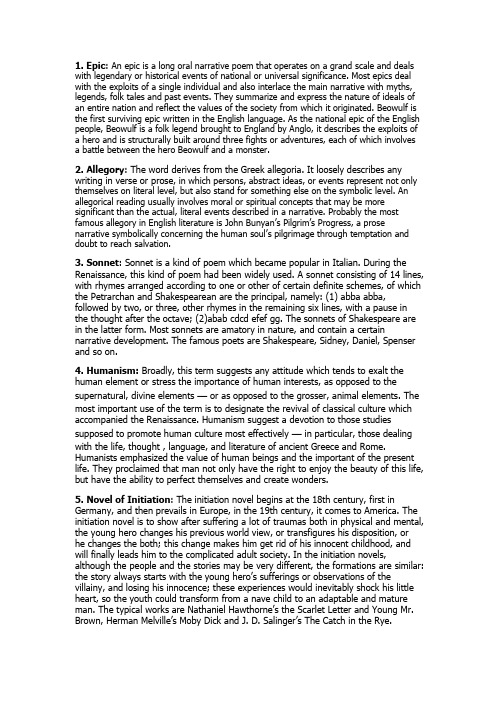
1. Epic: An epic is a long oral narrative poem that operates on a grand scale and deals with legendary or historical events of national or universal significance. Most epics deal with the exploits of a single individual and also interlace the main narrative with myths,legends, folk tales and past events. They summarize and express the nature of ideals of an entire nation and reflect the values of the society from which it originated. Beowulf is the first surviving epic written in the English language. As the national epic of the English people, Beowulf is a folk legend brought to England by Anglo, it describes the exploits of a hero and is structurally built around three fights or adventures, each of which involvesa battle between the hero Beowulf and a monster.2. Allegory: The word derives from the Greek allegoria. It loosely describes any writing in verse or prose, in which persons, abstract ideas, or events represent not only themselves on literal level, but also stand for something else on the symbolic level. An allegorical reading usually involves moral or spiritual concepts that may be more significant than the actual, literal events described in a narrative. Probably the most famous allegory in English literature is John Bunyan‟s Pilgrim‟s Progress, a prose narrative symbolically concerning the human soul‟s pilgrimage through temptation and doubt to reach salvation.3. Sonnet: Sonnet is a kind of poem which became popular in Italian. During the Renaissance, this kind of poem had been widely used. A sonnet consisting of 14 lines, with rhymes arranged according to one or other of certain definite schemes, of which the Petrarchan and Shakespearean are the principal, namely: (1) abba abba, followed by two, or three, other rhymes in the remaining six lines, with a pause in the thought after the octave; (2)abab cdcd efef gg. The sonnets of Shakespeare are in the latter form. Most sonnets are amatory in nature, and contain a certain narrative development. The famous poets are Shakespeare, Sidney, Daniel, Spenser and so on.4. Humanism: Broadly, this term suggests any attitude which tends to exalt the human element or stress the importance of human interests, as opposed to the supernatural, divine elements — or as opposed to the grosser, animal elements. The most important use of the term is to designate the revival of classical culture which accompanied the Renaissance. Humanism suggest a devotion to those studies supposed to promote human culture most effectively — in particular, those dealing with the life, thought , language, and literature of ancient Greece and Rome. Humanists emphasized the value of human beings and the important of the present life. They proclaimed that man not only have the right to enjoy the beauty of this life, but have the ability to perfect themselves and create wonders.5. Novel of Initiation: The initiation novel begins at the 18th century, first in Germany, and then prevails in Europe, in the 19th century, it comes to America. The initiation novel is to show after suffering a lot of traumas both in physical and mental, the young hero changes his previous world view, or transfigures his disposition, orhe changes the both; this change makes him get rid of his innocent childhood, and will finally leads him to the complicated adult society. In the initiation novels, although the people and the stories may be very different, the formations are similar: the story always starts with the young hero‟s sufferings or observations of the villainy, and losing his innocence; these experiences would inevitably shock his little heart, so the youth could transform from a nave child to an adaptable and mature man. The typical works are Nathaniel Hawthorne‟s the Scarlet Letter and Young Mr. Brown, Herman Melville‟s Moby Dick and J. D. Salinger‟s The Catch in the Rye.6. Quest: In mythology and literature, a quest, a journey towards a goal, serves asa plot device and (frequently) as a symbol. Quests appear in the folklore of every nation and also figure prominently in non-national cultures. In literature, the objects of quests require great exertion on the part of the hero, and the overcoming of many obstacles, typically including much travel. The aspect of travel also allows the storyteller to showcase exotic locations and cultures. The typical works are Homer's Odyssey, Herman M elville‟s Moby Dick and so on.7. Byronic Hero: Byronic hero is a proud and mysterious rebel figure of noble origin in Byron‟s …poems. With immense superiority in his passions and powers, the Byronic hero would carry on his shoulders the burden of righting all the wrongs in an evil society, and would fight single-handedly against any kind of tyrannical rules either in government, in religion or in moral principles with unconquerable will and inexhaustible energies. The conflict is usually one of rebellious individuals against outworn social systems and convention. Such a hero appears first in Childe Harold‟s pilgrimage and then further developed in later works such as Manfred and Don Juan.8. Gothic Fiction: Gothic Fiction means a style of writing popular in the late 18th century which produced stories set in lonely frightening places. Gothic Fiction invariably exploits ghosts and monsters and setting such as castles, dungeons and graveyards, which imparts a suitably sinister and terrifying atmosphere. The Gothic Fiction have opened up to later fictions the dark, irrational side of human nature —the savage egoism, the perverse impulses, and the nightmarish terror that lie beneath the controlled and ordered surface of the conscious mind. Gothic Fiction has exerted significant influence on the literature of later generations. The first Gothic Fiction is Horace Walpole‟s The Castle of Otranto.9. Naturalism: The word used to describe works of literature which use realistic methods and subjects to convey a philosophical form of naturalism; that is a belief that everything existed is a part of nature and can be explained by natural and material cause — and not by supernatural, spiritual or paranormal causes. Unlike realism, which focuses on literary technique, naturalism implies a philosophical position for naturalistic writers. Those in favor of s naturalistic approach to and interpretation of life concentrated on depicting the social environment dwelt particularly on its deficiencies and on the shortcoming of human beings. One of those significant works of naturalism is Theodore Dreiser’s Sister Carrie.10. Graveyard Poets: A term applied to eighteenth-century poets who wrote meditative poems, usually set in a graveyard, on the theme of human mortality, death, religion and melancholy. Their poems made frequent use of funereal or gloomy imagery; they were often very Christian writers who used the imagery of night, death, and gloom in spiritual contemplation of human mortality and our relation to the divine. Edward Young and Thomas Gray are famous poets of the Graveyard school.11. Metaphysical Poets: The metaphysical poets refer to a group of religious poets in the first half of the seventeenth century whose works were characterized by their wit, imaginative picturing, compressions, often cryptic expression, and play of paradoxes and juxtapositions of metaphor. They were against the convention of Elizabethan love poetry. They used contemporary scientific discoveries and theories, the topical debates on humanism, faith, and eternity, colloquial speech-based rhythms, and innovative verse forms, to examine the relationship between theindividual, his God, and the universe. The typical metaphysical poets are John Donne, Andrew Marvell.12. The Lost Generation: a group of U.S. writers who came of age during the war and established their literary reputations in the 1920s. The term stems from a remark made by Gertrude Stein to Ernest Hemingway, “You are all a lost generation.” Hemingway used it as an epigraph to The Sun Also Rises (1926). The generation was “lost” in the sense that its inherited values were no longer relevant in the postwar world and because of its spiritual alienation from a U.S. that, basking under President Harding's “back to normalcy” policy, seemed to its members to be hopelessly provincial, materialistic, and emotionally barren. The term embraces Hemingway, F. Scott Fitzgerald, and many other writers who made Paris the centre of their literary activities in the '20s. They were never a literary school. In the 1930s, as these writers turned in different directions, their works lost the distinctive stampof the postwar period.。
英美文学名词解释1
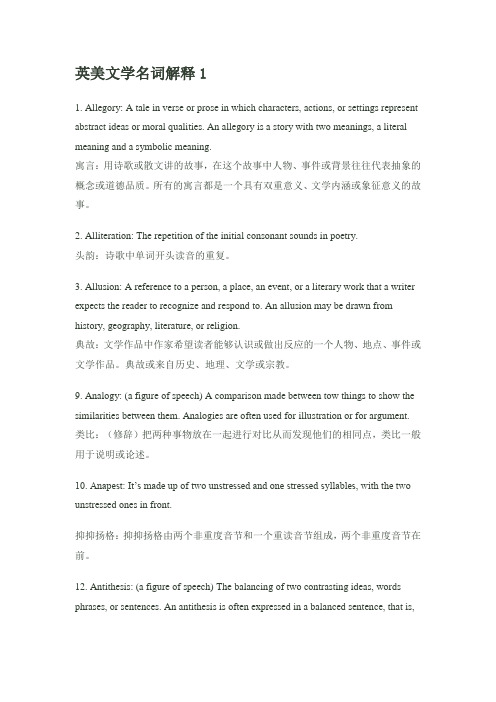
英美文学名词解释11. Allegory: A tale in verse or prose in which characters, actions, or settings represent abstract ideas or moral qualities. An allegory is a story with two meanings, a literal meaning and a symbolic meaning.寓言:用诗歌或散文讲的故事,在这个故事中人物、事件或背景往往代表抽象的概念或道德品质。
所有的寓言都是一个具有双重意义、文学内涵或象征意义的故事。
2. Alliteration: The repetition of the initial consonant sounds in poetry.头韵:诗歌中单词开头读音的重复。
3. Allusion: A reference to a person, a place, an event, or a literary work that a writer expects the reader to recognize and respond to. An allusion may be drawn from history, geography, literature, or religion.典故:文学作品中作家希望读者能够认识或做出反应的一个人物、地点、事件或文学作品。
典故或来自历史、地理、文学或宗教。
9. Analogy: (a figure of speech) A comparison made between tow things to show the similarities between them. Analogies are often used for illustration or for argument. 类比:(修辞)把两种事物放在一起进行对比从而发现他们的相同点,类比一般用于说明或论述。
英美文学名词解释总结
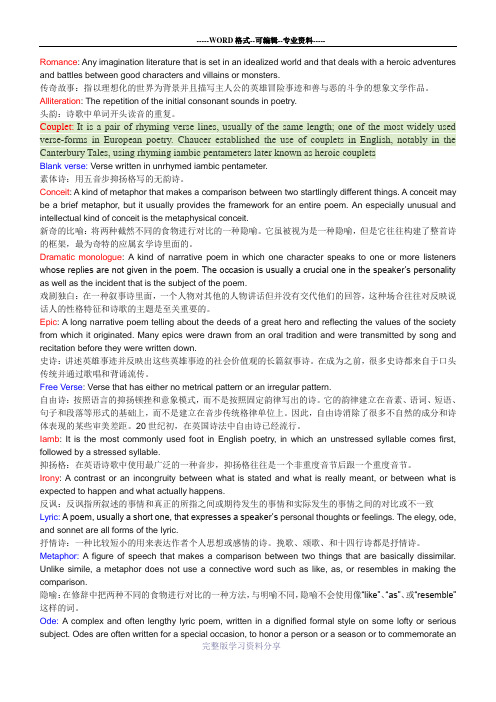
Romance: Any imagination literature that is set in an idealized world and that deals with a heroic adventures and battles between good characters and villains or monsters.传奇故事:指以理想化的世界为背景并且描写主人公的英雄冒险事迹和善与恶的斗争的想象文学作品。
Alliteration: The repetition of the initial consonant sounds in poetry.头韵:诗歌中单词开头读音的重复。
Couplet: It is a pair of rhyming verse lines, usually of the same length; one of the most widely used verse-forms in European poetry. Chaucer established the use of couplets in English, notably in the Canterbury Tales, using rhyming iambic pentameters later known as heroic coupletsBlank verse: Verse written in unrhymed iambic pentameter.素体诗:用五音步抑扬格写的无韵诗。
Conceit: A kind of metaphor that makes a comparison between two startlingly different things. A conceit may be a brief metaphor, but it usually provides the framework for an entire poem. An especially unusual and intellectual kind of conceit is the metaphysical conceit.新奇的比喻:将两种截然不同的食物进行对比的一种隐喻。
英美文学选读期末名词解释.doc
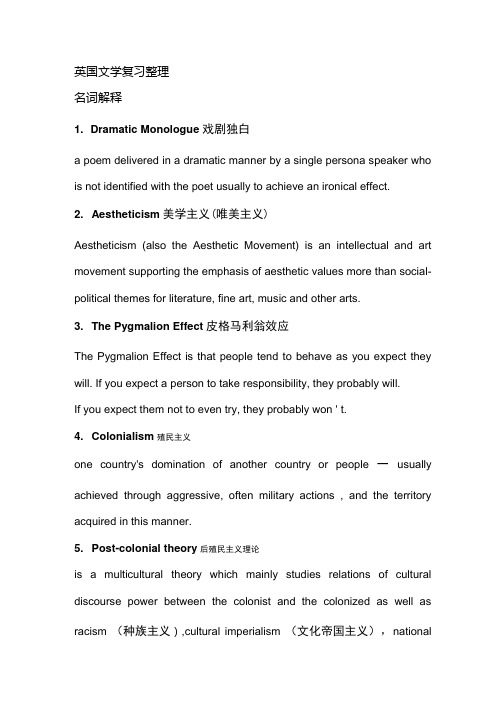
英国文学复习整理名词解释1. Dramatic Monologue 戏剧独白a poem delivered in a dramatic manner by a single persona speaker who is not identified with the poet usually to achieve an ironical effect.2. Aestheticism美学主义(唯美主义)Aestheticism (also the Aesthetic Movement) is an intellectual and art movement supporting the emphasis of aesthetic values more than social-political themes for literature, fine art, music and other arts.3. The Pygmalion Effect皮格马利翁效应The Pygmalion Effect is that people tend to behave as you expect they will. If you expect a person to take responsibility, they probably will.If you expect them not to even try, they probably won ' t.4. Colonialism 殖民主义one country's domination of another country or people一usually achieved through aggressive, often military actions , and the territory acquired in this manner.5. Post-colonial theory后殖民主义理论is a multicultural theory which mainly studies relations of cultural discourse power between the colonist and the colonized as well as racism (种族主义),cultural imperialism (文化帝国主义),nationalculture and culture power identity after colonial period Representatives后殖民理论的"圣三位一体"Edward Said(萨义德)Gayatri C. Spivak(斯皮瓦克)Homi K. Bhabha(霍米巴巴),6.lmagism意象主义The body of theories of a group of anti-Romantic and anti-Georgian British and American poets (1912-18)who aimed at simplicity and detachment in poetic expression by the clear presentation of visual images.,/.Imagery 意象Words or phrases that create picture, or images, in the reader mind.Images are primarily visual.Images can appeal to other senses as well: touch, taste, smell and hearing.8.Symbolism印象主义Epiphany 顿悟An experience of sudden and striking realization 顿.悟Epiphany is an appearance or perception of the essential nature or meaning of something, to describe the sudden revelation of whatness of a thing, the moment in which the soul of the commonest object seems tous radiant.9.Stream of Consciousness 意识流It is a narrative mode that seeks to portray an individual's point of v iewby giving the written equivalent of the character's thought proc esses, either in a loose interior monologue, or in connection to his or her actions. Stream of consciousness writing is usually regarded as a special form of interior monologue and is characterized by le aps in syntax and punctuation that can make the prose difficult to f ollow, tracing a character's fragmentary thoughts and sensory feeli ngs. The narrative method of capturing and representing the inner working of a character's mind.lO.Feminist Criticism 女性主义Feminism refers to movements aimed at establishing and defending equal political, economic, social rights and opportunities for women11 .Transcendentalists 超验主义Transcendentalists emphasize the importance of the individual. They believe that the individual is the most important part of society, and that social innovation can only be achieved through personal cultivation and improvement. Therefore, the primary responsibility of people is to improve themselves, rather than deliberately pursue wealth and wealth. An ideal person is one who depends on himself Transcendentalists look at nature in a new way, believing that nature is the symbol of super spiritor god. In their view, nature is more than matter. It has life, the spirit of god fills it, it is the cloak of the super spiritmbic pentameter(五音步诗)lambic pentameter is the most common English meter, in which each foot contains an unaccented syllable and an accented syllable. It is a meter in poetry, consisting of an unrhymed line with five iambs or feet (hence pentameter).13. Alliteration(头韵)Alliteration means a repetition of the initial sounds of several words in a line or group. It is a very old traditional stylistic device in English literature and verse. The consonants and stressed syllables are repeated in one line or in one stanza14. Byronic hero拜伦式英雄The Byronic hero presents an idealized, but flawed character whose attributes include: great talent; gr eat passion; distaste for society and social institutions; a lac k of respect for rank and privilege; being thwarted in love by social c onstr aint or death; rebellion; exile; an unpleasant secret past; arrogance; overconf idence or lac k of foresight; and, ultimately, a self-destructive manner.15.Sonnet十四行诗A sonnet is a 14-line lyric poem with a single theme. Sonnets vary butare usually written in iambic pentameter, following one of two traditional patterns: the Petrarchan or Italian sonnet and the Shakespeareanor English sonnet. A sonnet generally expresses a single theme or idea. ke Poets湖畔诗人The Lake Poets all lived in the Lake District of England at the turn of the nineteenth century. As a group, they followed no single "school" of thought or literary practice then known, although their works were uniformly disparaged by the Edinburgh Review. They are considered part of the Romantic Movement1/.Metaphysical玄学派诗歌的Metaphysical poets is a term coined by the poet and critic Samuel Johnson to describe a loose group of British lyric poets of the 17th century, whose work was characterized by the inventive use ofconceits, and by speculation about topics such as love or religion. John Donne is the most important representative.18.Shakespearean Comedy 莎士比亚式喜剧A Shakespearean comedy is one that has a happy ending, usually involving marriages between the unmarried characters, and a tone and style that is more light-hearted than Shakespeare's other plays. Shakespeare an comedies tend to also include: 'A struggle of young lovers to overcome difficulty, often presented by elder.。
英美文学名词解释
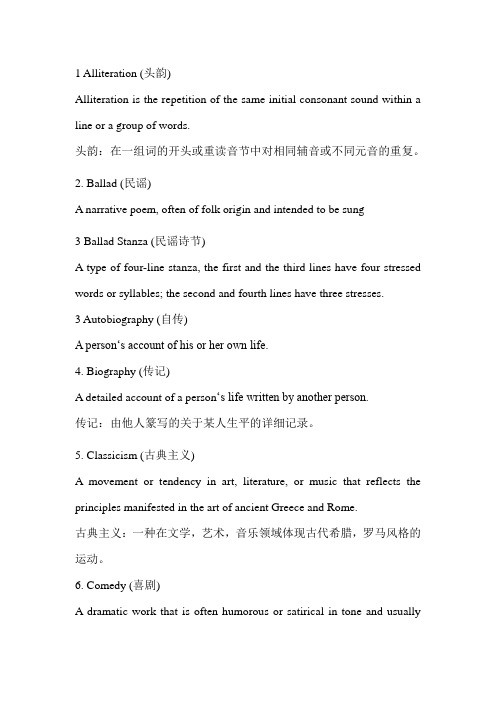
1 Alliteration (头韵)Alliteration is the repetition of the same initial consonant sound within a line or a group of words.头韵:在一组词的开头或重读音节中对相同辅音或不同元音的重复。
2. Ballad (民谣)A narrative poem, often of folk origin and intended to be sung3 Ballad Stanza (民谣诗节)A type of four-line stanza, the first and the third lines have four stressed words or syllables; the second and fourth lines have three stresses.3 Autobiography (自传)A person‘s account of his or her own life.4. Biography (传记)A detailed account of a person‘s life written by another person.传记:由他人篆写的关于某人生平的详细记录。
5. Classicism (古典主义)A movement or tendency in art, literature, or music that reflects the principles manifested in the art of ancient Greece and Rome.古典主义:一种在文学,艺术,音乐领域体现古代希腊,罗马风格的运动。
6. Comedy (喜剧)A dramatic work that is often humorous or satirical in tone and usuallycontains a happy resolution of the thematic conflict.喜剧:轻松的和常有幽默感的或在调子上是讽刺的戏剧作品,常包括主题冲突的愉快解决7. Conflict (冲突)A struggle between two opposing forces or characters in a short story, novel, play, or narrative poem.冲突:故事,小说,戏剧中相对的力量和人物之间的对立。
英美文学常用术语及解释
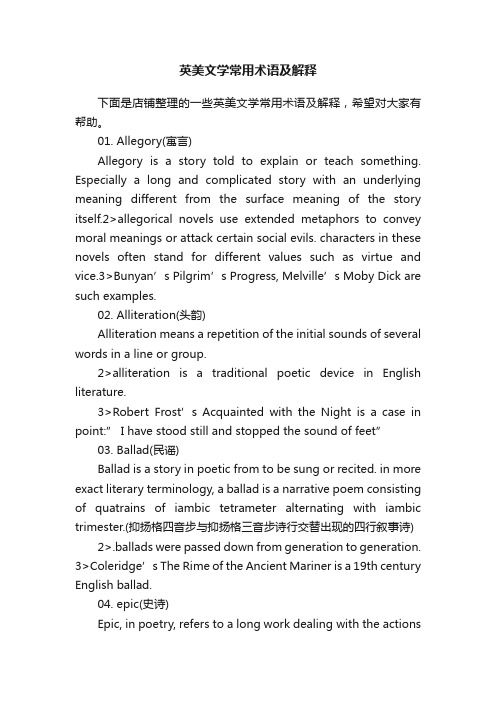
英美文学常用术语及解释下面是店铺整理的一些英美文学常用术语及解释,希望对大家有帮助。
01. Allegory(寓言)Allegory is a story told to explain or teach something. Especially a long and complicated story with an underlying meaning different from the surface meaning of the story itself.2>allegorical novels use extended metaphors to convey moral meanings or attack certain social evils. characters in these novels often stand for different values such as virtue and vice.3>Bunyan’s Pilgrim’s Progress, Melville’s Moby Dick are such examples.02. Alliteration(头韵)Alliteration means a repetition of the initial sounds of several words in a line or group.2>alliteration is a traditional poetic device in English literature.3>Robert Frost’s Acq uainted with the Night is a case in point:” I have stood still and stopped the sound of feet”03. Ballad(民谣)Ballad is a story in poetic from to be sung or recited. in more exact literary terminology, a ballad is a narrative poem consisting of quatrains of iambic tetrameter alternating with iambic trimester.(抑扬格四音步与抑扬格三音步诗行交替出现的四行叙事诗)2>.ballads were passed down from generation to generation.3>Coleridge’s The Rime of the Ancient Mariner is a 19th century English ballad.04. epic(史诗)Epic, in poetry, refers to a long work dealing with the actionsof goods and heroes.2>Epic poems are not merely entertaining stories of legendary or historical heroes; they summarize and express the nature or ideals of an entire nation at a significant or crucial period of its history.3>Beowulf is the greatest national Epic of the Anglo-Saxons.05. Lay(短叙事诗)It is a short poem, usually a romantic narrative, intended to be sung or recited by a minstrel.06. Romance(传奇)Romance is a popular literary form in the medic England.2>it sings knightly adventures or other heroic deeds.3>chivalry is the spirit of the romance.07. Alexandrine(亚历山大诗行)The name is derived from the fact that certain 12th and 13th century French poems on Alexander the Great were written in this meter.2>it is an iambic line of six feet, which is the French heroic verse.08. Blank Verse(无韵诗或素体广义地说)Blank verse is unrhymed poetry. Typically in iambic pentameter, and as such, the dominant verse forms of English dramatic and narrative poetry since the mid-16th century.09. Comedy(喜剧)Comedy is a light form of drama that aims primarily to amuse and that ends happily. Since it strives to provoke smile and laughter, both wit and humor are utilized. In general, the comic effect arises from recognition of some incongruity of speech, action, or character revelation, with intricate plot.10. Essay(随笔)The term refers to literary composition devoted to the presentation of the writer’s own ideas on a topic and generally addressing a particular aspect of the subject. Often brief in scope and informal in style, the essay differs from such fomal forms as the thesis, dissertation or treatise.11. Euphuistic style(绮丽体)Its principle characteristics are the excessive use of antithesis, which is pursued regardless of sense, and emphasized by alliteration and other devices; and of allusions to historical and mythological personages and to natural history drawn from such writers as Plutarch(普卢塔克), Pliny(普林尼), and Erasmus(伊拉兹马斯).2>it is the peculiar style of Euphues(优浮绮斯)12. History Plays(历史剧)History plays aim to present some historical age or character, and may be either a comedy or a tragedy. They almost tell stories about the nobles, the true people in history, but not ordinary people. the principle idea of Shakespeare’s history plays is the necessity for national unity under a mighty and just sovereign.13. Masques or Masks(假面剧)Masques (or Masks) refer to the dramatic entertainments involving dances and disguises, in which the spectacular and musical elements predominated over plot and character. As they were usually performed at court, often at very great expense, many have political overtones.14. Morality plays(道德剧)A kind of medic and early Renaissance drama that presents the conflict between the good and evil through allegorical characters. The characters tend to be personified abstractions of vices and virtues, which can be named as Mercy. Conscience, etc. unlike a mystery or a miracle play, morality play does notnecessarily use Biblical or strictly religious material because it takes place internally and psychologically in every human being.15.Sonnet(十四行诗)It is a lyric poem of 14 lines with a formal or recited and characterized by its presentation of a dramatic or exciting episode in simple narrative form.2>it is one of the most conventional and influential forms of poetry in Europe.3>Shakespeare’s sonnets are well-known.16. Spenserian Stanza(斯宾塞诗节)Spenserian Stanza is the creation of Edmund spenser.2>it refers to a stanza of nine lines, with the first eight lines in iambic pentameter(五音步抑扬格) and the last line in iambic hexameter(六音步抑扬格),rhyming ababbcbcc. 3>Spenser’s the Faerie Queen was written in this kind of stanza.17. Stanza(诗节)Stanza is a group of lines of poetry, usually four or more, arranged according to a fixed plan.2>the stanza is the unit of structure in a poem and poets do not vary the unit within a poem.18. Three Unities(三一原则)Three rules of 16th and 17th century Italian and French drama, broadly adapted from Aristotle’s Poetics<诗学>:2>the unity of time, which limits a play to a single day; the unity of place, which limits a play’s setting in a single location; and the unity of action, which limits a play to a single story line.19. Tragedy(悲剧)In general, a literary work in which the protagonist meets an unhappy or disastrous end. Unlike comedy, tragedy depicts the actions of a central character who is usually dignified or heroic.20.Conceit(奇特比喻)Conceit is a far-fetched simile or metaphor, a literary conceit occurs when the speaker compares two highly dissimilar things.2>conceit is extensively employed in John Donne’s poetry.21.Metar(格律)The word”meter” is derived from the Greek word”metron” meaning”measure”.2>in English when applied to poetry, it refers to the regular pattern of stressed and unstressed syllables.3>the analysis of the meter is called scansion(格律分析)22. University Wits(大学才子)University Wits refer to a group of scholars during the Elizabethan Age who graduated from either oxford or Cambridge. They came to London with the ambition to become professional writers. Some of them later became famous poets and playwrights. They were called” University Wits”23.Foreshadowing(预兆)Foreshadowing, the use of hints or clues in a novel or drama to suggest what will happen next. Writers use Foreshadowing to create interest and to build suspense.method used to build suspense by providing hints of what is to come.24. Soliloquy(独白)Soliloquy, in drama, means a moment when a character is alone and speaks his or her thoughts aloud..2>the line“to be, or no t to be, that is the question”, which begins the famous soliloquy from Shakespeare’s Hamlet.25.Narrative Poem(叙述诗)Narrative Poem refers to a poem that tells a story in verse,2>three traditional types of narrative poems include ballads,epics, metrical romances.3>it may consist of a series of incidents, as John Milton’s paradise lost.26.Robin Hood(罗宾.豪)Robin hood is a legendary hero of a series of English ballads, some of which date from at least the 14th century.2>the character of Robin Hood is many-sided. Strong, brave and intelligent, he is at the same time tender-hearted and affectionate.3>the dominant key in his character is his hatred for the cruel oppression and his love for the poor and downtrodden.4>another feature of Robin’s view is his reverence for the king, Robin Hood was a people’s hero.27. Beowulf(贝奥武甫)Beowulf, a typical example of old English poetry, is regarded as the greatest national epic of t he Anglo-Saxons. 2>the epic describes the exploits of a Scandinavian hero, Beowulf, in fighting against the monster Grendel, his revengeful nother, and a fire-breathing dragon in his declining years. While fight against the dragon, Beowulf was mortally wounded, however, he killed the dragon at the cost of his life, Beowulf is shown not only as a glorious hero but also as a protector of the people.28. Baroque(巴罗克式风格)This is originally a term of abuse applied to 17th century Italian art and that of other countries. It is characterized by the unclassical use of classical forms, in a literary context; it is loosely used to describe highly ornamented verse or prose, abounding in extravagant conceits.这原本是用来指17世纪的意大利艺术和其他国家艺术滥用的一个术语.这种风格主要是指对古典形式的非古典运用.在文学领域,这种风格松散地用来指十分雕饰的,大量运用奇思妙想的诗歌或散文.29. Cavalier poets(骑士派诗人)A name given to supporters of Charles I in the civil war. These poets were not a formal group, but all influenced by Ben Jonson and like him paid little attention to the sonnet. Their lyrics are distinguished by short lines, precise but idiomatic diction, and an urbane and graceful wit.30. Elegy(挽歌)Elegy has typically been used to refer to reflective poems that lament the loss of something or someone, and characterized by their metrical form.31. Restoration Comedy(复辟时期喜剧)Restoration Comedy, also the comedy of manners, developed upon the reopening of the theatres after the re-establishment of monarchy with the return of Charles II.. Its predominant tone was witty, bawdy, cynical, and amoral. Standard characters include fops, bawds, scheming valets, country squires, and sexually voracious young widows and older women. The principle theme is sexual intrigue, either for its own sake or for money.复辟时期的喜剧,又称社会习俗讽刺喜剧,是在查理二世君主复辟后剧院重新开业的基础上发展起来的,其主要的基调是诙谐,淫秽,挖苦和非道德.标准的角色包括花花公子,鸨母,诡计多端的仆人,乡绅,性欲旺盛的年轻寡妇和老女人.主要的主题是奸情,有的是为了性,有的是为了钱.。
《英美文学史》名词解释
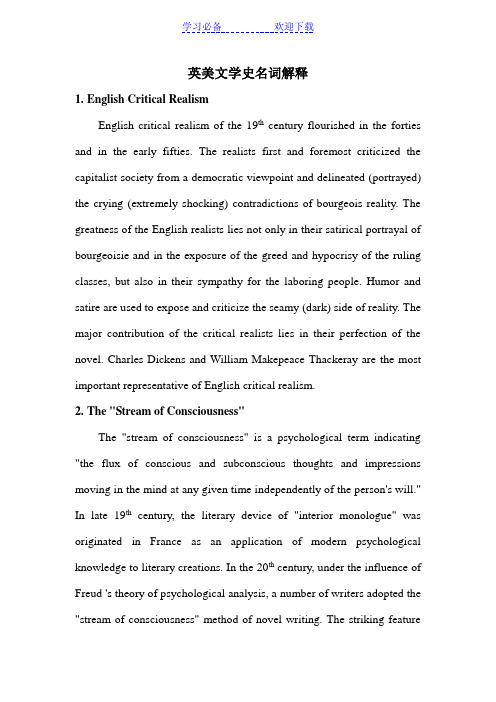
英美文学史名词解释1.English Critical RealismEnglish critical realism of the 19th century flourished in the forties and in the early fifties. The realists first and foremost criticized the capitalist society from a democratic viewpoint and delineated (portrayed) the crying (extremely shocking) contradictions of bourgeois reality. The greatness of the English realists lies not only in their satirical portrayal of bourgeoisie and in the exposure of the greed and hypocrisy of the ruling classes, but also in their sympathy for the laboring people. Humor and satire are used to expose and criticize the seamy (dark) side of reality. The major contribution of the critical realists lies in their perfection of the novel. Charles Dickens and William Makepeace Thackeray are the most important representative of English critical realism.2.The "Stream of Consciousness"The "stream of consciousness" is a psychological term indicating "the flux of conscious and subconscious thoughts and impressions moving in the mind at any given time independently of the person's will." In late 19th century, the literary device of "interior monologue" was originated in France as an application of modern psychological knowledge to literary creations. In the 20th century, under the influence of Freud 's theory of psychological analysis, a number of writers adopted the "stream of consciousness" method of novel writing. The striking featureof these novelists is their giving precedence to the depiction of the characters' mental and emotional reactions to external events, rather than the events themselves. In doing so, the novelists abandoned the conventional usages of realistic plot structure, characterization and description, and their works became successions of "fleeting images of the external world mingled with thoughts and half-thoughts and shadows of thought attached to the immediate present or moving back and forth in memory." James Joyce and Virginia Woolf are the two best known novelists of the "stream of consciousness".3.TranscendentalismTranscendentalism is the summit of the Romantic Movement in the history of American literature in the 19th century. Transcendentalism has been defined philosophically as "the recognition in man of the capacity of knowing truth intuitively". Transcendentalists place emphasis on the importance of the Over-soul, the individual and Nature. The most important representatives are Ralph Waldo Emerson and Henry David Thoreau.4.RenaissanceRenaissance in European history refers to the period from 14th century to 17th century. "Renaissance" means "revival", the revival of interest in Ancient Greek and Roman culture and getting rid of conservatism in feudalist Europe and introducing new ideas that expressthe interests of the rising bourgeoisie. It started in Italy and ended in England and Spain. Renaissance has two striking features. One is a thirsting curiosity for the classical literature; the other is the keen interest in the activities of humanity. Humanism is the key-note of the Renaissance. Thomas More and William Shakespeare are the best representatives of the English humanists.5.Passive RomanticismEnglish romanticism began when Lyrical Ballad was published in 1798 and ended in 1832. It in effect is a revolt of the English imagination against the neoclassical reason. The romanticists who saw both the corruption of the feudal societies and the inhumanity of capitalism and felt that the society denied people their essential human needs. They were discontented with, and opposed to the development of capitalism. Some romantic writers reflected the thinking of classes ruined by the bourgeoisie, and by way of protest against capitalism development turned to the feudal past, i.e., the "merry old English", as their ideal, or, "frightened by the coming of industrialism and the nightmare towns of industry, they were turning to nature to nature for protection." These were the elder and sometimes called passive or escapist romantics, represented by Wordsworth and Coleridge.6. ImagismImagism is a Movement in U.S. and English poetry characterized bythe use of concrete language and figures of speech, modern subject matter, metrical freedom, and avoidance of romantic or mystical themes, aiming at clarity of expression through the use of precise visual images. It grew out of the Symbolist Movement in 1912 and was initially led by Ezra Pound, Amy Lowell, and others. The Imagist manifesto that came out in 1912 showed three Imagist poetic principles: direct treatment of the “thing” (no fuss, frill or ornament), exclusion of superfluous words (precision and economy of expression), the rhyme of the musical phrase rather than the sequence of a metronome (free verse form and music).7. The Local Color MovementThe local color movement came into particular prominence in America after the Civil War, perhaps as an attempt to recapture the glamour of a past era, or to portray the sections of the reunited country. Local color as a literary school emphasizes its setting, being concerned with the character of a district or of an era, as marked by its customs, dialects costumes, landscape or other peculiarities that have escaped standardizing cultural influences. In local color literature, one finds the dual influence of romanticism and realism since the author frequently looks away from ordinary life to distant lands, strange customs, or exotic scenes, but retains through minute detail a sense of fidelity and accuracy of description. Mark Twain is a representative of the American Local Colorism.8. The Lost GenerationThe Lost Generation is applied to the American writers who fought in the First World War, voluntarily exiled to Paris, and associated with the informal literary saloon of Gertrude Stein’s Paris home for a certain period of time. They were all disillusioned with the American Tradition of writing as well as the post-war American society. The most eloquent spokesman of the group is Earnest Hemingway. Other writers are Ezra Pound, Fitzgerald, etc..。
英美文学名词解释汉语版

英美文学名词解释汉语版
1. 小说 (Novel): 是一种长篇的虚构故事,通常以人物形象和情节为主要构成要素。
2. 散文 (Prose): 是一种以自由的、非诗歌形式的文学作品,通常有较为正式的句子结构和逻辑表达方式。
3. 诗歌 (Poetry): 是一种以押韵、节奏和音乐性为特点的文学形式,通常用比喻、象征和意象来表达作者的情感和观点。
4. 戏剧 (Drama): 是一种能够在舞台上演出的文学形式,通常包括对话、角色互动和舞台指导。
5. 悲剧 (Tragedy): 是一种戏剧类型,通常描绘了主角在命运和自身缺陷之间的斗争,并以悲惨结局告终。
6. 喜剧 (Comedy): 是一种戏剧类型,通常以幽默和滑稽情节为特点,旨在给观众带来愉快和欢笑。
7. 叙事诗 (Epic poem): 是一种长篇叙事诗歌,从古代传统英雄故事中派生而来,通常讲述了一个英雄或重大事件的史诗式叙事。
8. 短篇小说 (Short story): 是一种长度较短的虚构故事,通常聚焦于一个具体的事件或角色,呈现出作者的观点或主题。
9. 传记 (Biography): 是一种通过详细描述一个人的生平和事迹来记录他们的生活和成就的文学作品。
10. 自传 (Autobiography): 是一种以作者自己的经历和回忆为基础写成的传记,通常描绘了作者的成长经历和个人观点。
英美文学史名词解释(按照时间+特点+代表人物)

英美文学史名词解释期末背诵(按照时间+特点+代表人物):(注:英国文学简史作者刘炳善美国文学史作者常耀信)1.English Renaissance(英):The English Renaissance which means rebirth and revival sprang first in Italy in the 14th century and gradually spread to Europe. Two features are striking of this movement.The one is a thirsting curiosity for the classical literature.Another feature is the keen interest of humanity. Humanism is the key-note of the Renaissance.The representative writers are Thomas More and Edmund Spenser.2.Classicism(英):Classicism prevailed during the 18th century in England. The Classicists modeled themselves on Greek and Latin authors, and tried to control literary creation by some fixed laws and rules drawn from Greek and Latin works.It is a movement or tendency in art, literature or music that reflects the principles manifested in the art of ancient Greece and Rome. The representative writers are Addison, Steele.3.Sentimentalism(英):Sentimentalism came into being by the middle of 18th century as a result of a bitter discontent among the enlightened people with social reality and turned to the countryside for its material. Literary work of the sentimentalism is marked by a sincere sympathy for the poverty-stricken,expropriated peasants. They wrote the “simple annals of the poor”, though still in a classical style. Its appearance and development marks the midway in the transition from classicism to Romanticism in English poetry.The representative writers are Thomas Gray and William Cowper.4.Romanticism(英)At the turn of the 18th and I9th centuries romanticism appeared in England as a new trend in literature.The general feature of the works of the romanticists is a dissatisfaction with the bourgeois society. Their writings are filled with strong-willed heroes, formidable events, tragic situations, powerful conflicting passions, and exotic pictures.The romanticists paid great attention to the spiritual and emotional life of man.The representative writers are Scott and Byron.5.Passive romanticism(英)During the period 1798-1832,some romantic writers reflected the thinking of classes ruined by the bourgeoisie, and by way of protest against capitalist development turned to the feudal past, i.e. the " merry old England," as their ideal, or "frightened by the coming of industrialism and the nightmare towns of industry, they were turning to nature for protection. " The representative writers are Wordsworth and Coleridge. 6.Active romanticism(英)During the period 1798-1832,some writers expressed the aspirations of the classes created by capitalism and held out an ideal, though a vague one, of a future society free from oppression and exploitation. These were the younger generation of romanticists and sometimes called active romanticists represented by Byron, Shelley and Keats.7.Critical Realism(英)It appeared in Victorian Age. English critical realism of the 19th century flourished in the forties and in the early fifties. The critical realists described with much vividness and great artistic skill the chief traits of the English society and criticized the capitalist system from a democratic viewpoint.It found its expression in the form of novel.The representative writers are Dickens and Thackeray.8.Stream of consciousness technique(英)In late 19th century, the literary device of “interior monologue” was originated in France.In the 20th century, a number of writers adopted the"'stream of consciousness" method of novel writing.The striking feature of these novelists is their giving precedence to the depiction of the characters' mental and emotional reactions to external events. rather than the events themselves.The representative writers are James Joyce and Virginia Woolf.9.Transcendentalism(美)Transcendentalism is the summit of the Romantic Movement in the history of American literature in the19th century. The major features are as follow: First Transcendentalists place emphasis on spirit, or the Over-soul as the most important thing. Secondly, the Transcendentalists stress the importance of the individual which they think is the most important element of society. Thirdly,they offer a fresh perception of nature as symbolic of the Spirit or God. The representative writer is Ralph Waldo Emerson and Thoreau.10.Local Colorism(美)It as a trend became dominant in American literature in the late 1860s and early 1870s. It is a variation of American literary realism. Generally, the local colorists concerned themselves with presenting and interpreting the local character of their regions. The characteristic setting is the isolated small town. This kind of fiction depicts the characters from a specific setting or of an era,which are marked by its customs,dialects,landscape or other peculiarities that have escaped standardizing cultural influence.The representative writer is Mark Twain and Bret Harte.11.Naturalism(美)Naturalism was a literary movement taking place from 1880's to 1940's that used detailed realism to suggest that social conditions, heredity, and environment had inescapable force In shaping human character. It was depicted as a literary movement that seeks to replicate a believable everyday reality. Darwinism had an evident influence of naturalism. It seemed to stress the animality of man, to suggest that man was dominated by the forces of evolution. The representative writer is Crane and Theodore Dreiser.12.Imagism(美)Imagism came between 1912 and 1922 as a great boom in Poetry. Imagism meets the need of expressing the temper of the age, is one of the modern literary movements. And Imagism has three principles: the first one is direct treatment of the 'thing' whether subject or objective. The second one is to use absolutely no word that does not contribute to the presentation. The last one is as regarding rhythm, to compose in the sequence of musical phrase, not in sequence of a metronome.An 'Image' is that which presents an intellectual and emotional complex in an instant oftime.The representative writer is Ezra Pound and Amy Lowell.13.The lost generation(美)The lost generation appeared after World War I. The term is applied to the American writers who fought in the First World War, voluntarily exiled to Paris, and associated with the informal literary saloon of Gertrude Stein's Paris home for a certain period of time. They were all disillusioned with the American Tradition of writing as well as the post-war American society. The representative writer is Earnest Hemingway and Fitzgerald.14.The beat generation(美):“Beat”literature offered something like a fresh breath of wind both in the prose and poetry of the 1950s and 1960s when there was a widespread discontentment among the postwar generation,whose voice was one of protest against all the mainstream culture that American had come to represent. The word”beat”represented a non-conformist.rebellious attitude toward conventional values concerning sex, religion, the arts, and the American way of life;It was an attitude resulted from the feeling of depression and exhaustion and the need to escape into an unconventional, sometimes communal, mode of living.The representatives are Allen Ginsberg and William Burroughs.15.The Harlem Renaissance(美):Harlem Renaissance is the new upsurge of African American literature in the 1920s when large numbers of African Americans from all places and all walks of life gathered in Harlem and rebelled against the values of their fathers and their way of life,when they took an enormous interest in their own lives and values,when they began a search for a distinct tradition of their own. The representatives are Langston Hughes and Jean Toomer.。
英美文学史名词解释
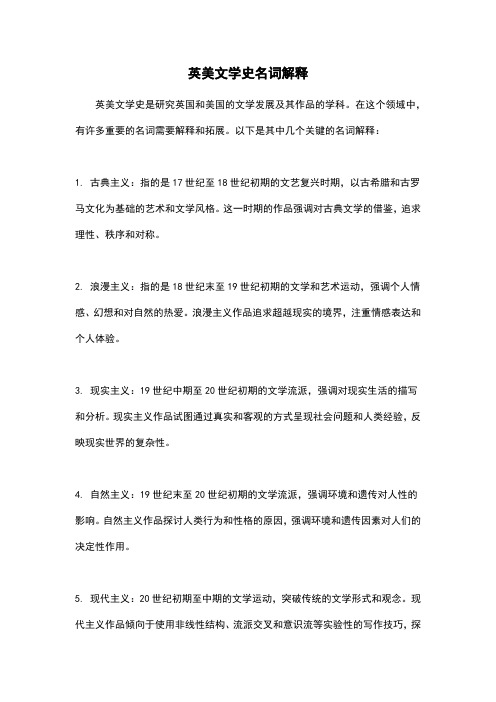
英美文学史名词解释
英美文学史是研究英国和美国的文学发展及其作品的学科。
在这个领域中,有许多重要的名词需要解释和拓展。
以下是其中几个关键的名词解释:
1. 古典主义:指的是17世纪至18世纪初期的文艺复兴时期,以古希腊和古罗马文化为基础的艺术和文学风格。
这一时期的作品强调对古典文学的借鉴,追求理性、秩序和对称。
2. 浪漫主义:指的是18世纪末至19世纪初期的文学和艺术运动,强调个人情感、幻想和对自然的热爱。
浪漫主义作品追求超越现实的境界,注重情感表达和个人体验。
3. 现实主义:19世纪中期至20世纪初期的文学流派,强调对现实生活的描写和分析。
现实主义作品试图通过真实和客观的方式呈现社会问题和人类经验,反映现实世界的复杂性。
4. 自然主义:19世纪末至20世纪初期的文学流派,强调环境和遗传对人性的影响。
自然主义作品探讨人类行为和性格的原因,强调环境和遗传因素对人们的决定性作用。
5. 现代主义:20世纪初期至中期的文学运动,突破传统的文学形式和观念。
现代主义作品倾向于使用非线性结构、流派交叉和意识流等实验性的写作技巧,探
索意识、时间和现代社会的复杂性。
除了这些名词,还有许多其他重要的概念和作品,如文艺复兴、启蒙运动、维多利亚时代、现代派诗歌、战争文学等。
研究英美文学史可以帮助我们了解不同时期的文学发展和作品背后的思想、价值观和文化背景。
- 1、下载文档前请自行甄别文档内容的完整性,平台不提供额外的编辑、内容补充、找答案等附加服务。
- 2、"仅部分预览"的文档,不可在线预览部分如存在完整性等问题,可反馈申请退款(可完整预览的文档不适用该条件!)。
- 3、如文档侵犯您的权益,请联系客服反馈,我们会尽快为您处理(人工客服工作时间:9:00-18:30)。
1.Alliteration:Alliteration is the repetition of a speech sound in a sequence of nearby
words. The term is usually applied only to consonants, and only when the recurrent sound begins a word or a stressed syllable within a word. In old English alliteration is the principle organizing device of the verse line.
2.Romance:Romance is a long composition, sometimes in verse, sometimes in prose,
describing the life and adventure of a noble hero. Romance was characteristic of the early feudal age, as it reflected the spirit of chivalry. The content of romance was usually about love, chivalry, and religion.
3.Soliloquy is a dramatic speech delivered by one character speaking aloud while under
the impression of being alone. The soliloquist thus reveals his inner thoughts and feelings to the audience. It is also known as interior monologue.
4.sonnet: A sonnet is a short song in the original meaning of the word. Later it became a
poem of 14 lines, usually in iambic pentameter with various rhyming schemes.
5.Conceit--- a kind of metaphor that makes a comparison between two startling different
things. A conceit may strike the readers weird at first glance, but proves appropriate in the end.
6.The name applied to an intellectual movement which developed in Western Europe
during the seventeenth century and reached its height in the eighteenth. The common element was a trust in human reason as adequate to solve the crucial problems and to establish the essential norms in life, together with the belief that the application of reason was rapidly dissipating the remaining feudal traditions. It influenced lots of famous English writers especially those neoclassic writers, such as Alexander Pope, Samuel Johnson etc..
7.Renaissance refers to the period between the 14th and mid-17th centuries. It makes a
transition from the medieval to the modern world. It started in Italy with the flowering of painting, sculpture and literature, and then spread to the rest of Europe. The term Renaissance means rebirth or revival. The Renaissance period was marked by a reawakening of interest in learning, in the individual and in the world of nature. The revival of learning led scholars back to the culture of Greece and Rome. The rebirth of interest in the individual gave rise to a new appreciation of beauty, to a desire for self-expression in varied activities and to the creation of art. The renewal of curiosity about the nature word ultimately drew men to discover new lands and new scientific truths.。
